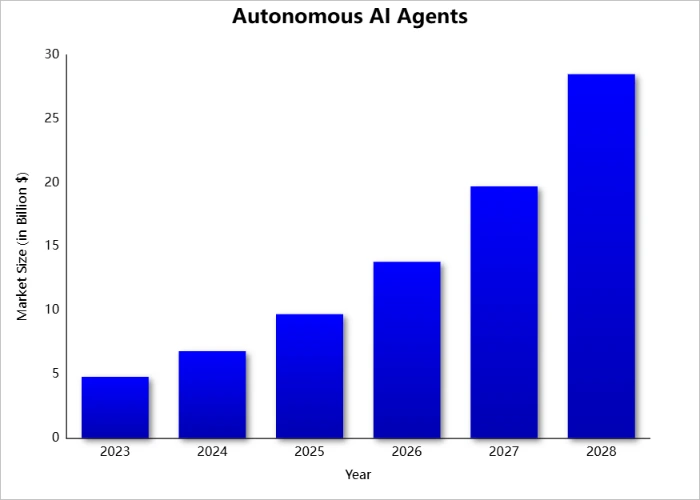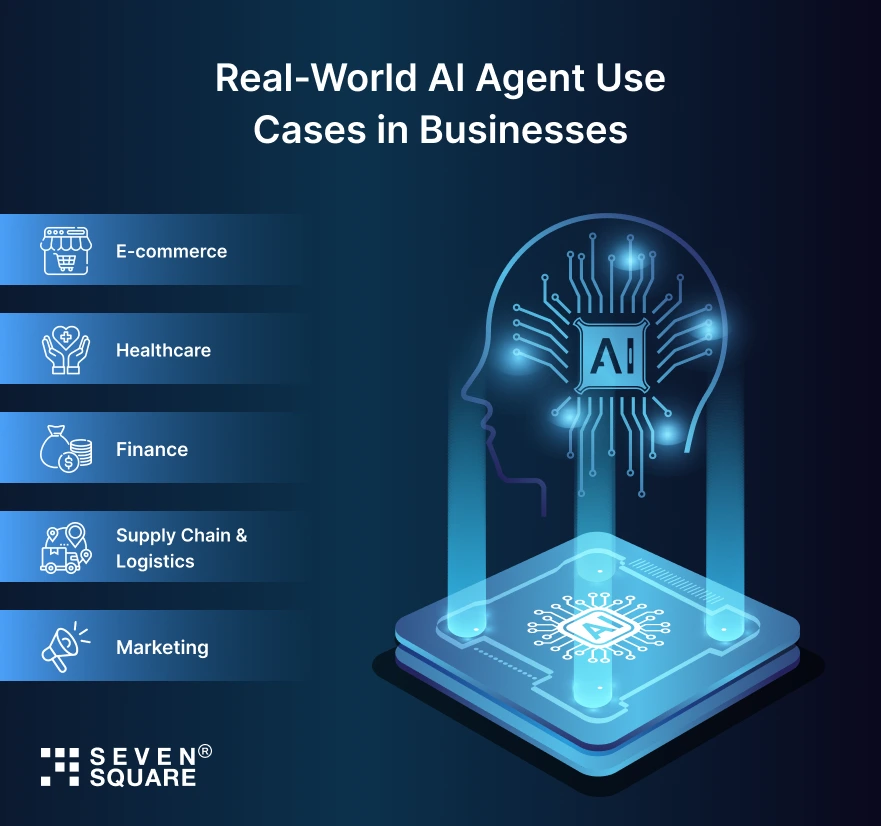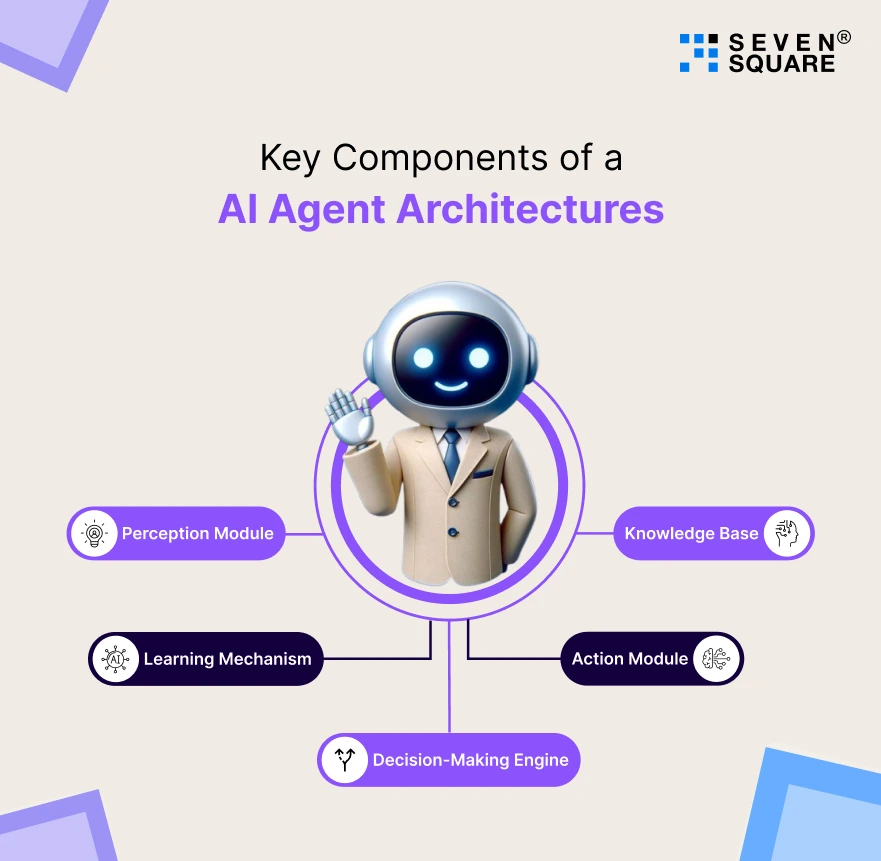Autonomous AI agents are self-operating software programs that can analyze data, make decisions, and take actions without human intervention.
Traditional automation follows predefined rules but these AI agents learn from their environment, adapt to new situations, and continuously improve their responses.
Think of them as virtual employees as they can answer customer queries, process transactions, and optimize workflows without constant supervision.
Are you thinking about building AI agents? Then you are at the right place.
The market of autonomous AI agents is expected to reach $28.5 billion at a CAGR of 43% in 2028.
In this blog, we tried to explain a step-by-step guide for AI agent development so you can enjoy AI-powered automation in your business.

Source: MarketsandMarkets
Why Autonomous AI Agents are Necessary for AI-Powered Automation?
Businesses depend upon speed, efficiency, and accuracy to stay competitive.
AI-powered automation takes traditional automation to the next level by allowing systems to operate intelligently and autonomously.
Autonomous AI agents help companies:
- Save Time: Automate repetitive tasks to free up human workers for strategic work.
- Better Accuracy: Reduce errors in data processing, decision-making, and customer interactions.
- Improve Efficiency: Optimize operations by predicting issues and resolving them proactively.
- Deliver Personalized Experiences: AI agents analyze user behavior to offer personalized recommendations and support.
Real-World AI Agent Use Cases in Businesses

Autonomous AI agents are already changing industries in powerful ways:
- E-commerce: AI chatbots provide 24/7 customer support, recommend products, and handle returns automatically.
- Healthcare: Virtual health assistants analyze medical records, schedule appointments, and remind patients about medications.
- Finance: AI-driven trading bots predict stock market trends and execute trades in real-time.
- Supply Chain & Logistics: Intelligent AI agents optimize delivery routes, track shipments, and reduce delays.
- Marketing: AI tools create personalized ads, analyze customer sentiment, and suggest the best engagement strategies.
Learn about top AI chatbots for eCommerce.
As AI technology improves, the potential for autonomous AI agents will only continue to grow and change how businesses operate and compete.
How Autonomous AI Agents Work: The Key Building Blocks?
To build powerful autonomous AI agents, it’s necessary to understand how they work behind the scenes.
Their architecture is designed to process information, make decisions, and take action just like a human would, but faster and with more accuracy.
Key Components of AI Agent Architectures

Every AI agent architecture has a few core components that allow it to function autonomously:
- Perception Module: Collects data from various sources (text, images, speech, or sensors) and interprets it.
- Decision-Making Engine: Uses algorithms and machine learning models to analyze data and determine the best course of action.
- Knowledge Base: Stores and retrieves information for context-aware decision-making.
- Action Module: Executes tasks, whether it’s responding to a query, generating content, or automating workflows.
- Learning Mechanism: Continuously improves through feedback & adapts to new situations over time.
These components work together to make AI agents smarter, efficient, and capable of handling complex tasks with minimal human intervention.
How do AI Agent Frameworks Work?
AI agent frameworks provide the foundation for developing, training, and deploying AI agents.
These frameworks include pre-built tools, libraries, and models that make development faster and more efficient.
- LangChain: Perfect for building AI agents that process and generate text-based responses.
- AutoGPT: Allows fully autonomous AI agents that can perform multi-step tasks with little guidance.
- Microsoft Autonomous Agents: Helps integrate AI agents into enterprise-level applications.
These frameworks simplify AI agent development by handling tasks like data processing, machine learning model integration, and real-time decision-making.
The Role of Machine Learning and Natural Language Processing (NLP)
AI-powered automation is machine learning (ML) and natural language processing (NLP) that allows AI agents to understand, learn, and interact with humans naturally.
1. Machine Learning(ML):
- Helps AI agents recognize patterns, make predictions, and improve decision-making.
- Allows agents to learn from data and user interactions to make them smarter over time.
2. Natural Language Processing(NLP):
- Allows AI agents to understand human language, interpret intent, and generate meaningful responses.
- Used in AI chatbots, voice assistants, and customer support automation.
How We Are Your Trusted Partner in AI Agent Development?
We specialize in AI agent development to deliver modern, scalable, and high-performance autonomous AI solutions. Here’s why businesses trust us:
- Expert AI Development Team: Our skilled engineers build custom AI agents according to your business needs and industry requirements.
- Proven AI-Powered Automation Solutions: We have successfully implemented AI-powered automation to optimize workflows and boost business efficiency.
- End-to-End AI Agent Development: From ideation to deployment, we handle every stage of AI agent development accurately.
- Scalable AI Models for Enterprises: We design autonomous AI models that scale with your business for long-term sustainability.
- Optimized AI Performance & Speed: We fine-tune AI models for fast response times, real-time decision-making, and superior accuracy.
- Industry-Specific AI Implementations: We develop AI solutions for various industries like healthcare, finance, logistics, eCommerce, and more.
Step 1: Defining the Purpose of Your AI Agent
Before you start building AI agents, the most important step is to define their purpose.
What problem will your AI agent solve? How will it add value?
Answering these questions will set a clear direction for development and ensure your AI-powered automation works effectively.
Identifying the Problem Your AI Agent Will Solve
To create a useful autonomous AI agent, you need to focus on a specific challenge that businesses or users face. Here are some examples:
- Customer Support: AI chatbots that handle frequently asked questions, troubleshoot issues, and provide real-time assistance.
- Task Automation: AI agents that schedule meetings, send reminders, and manage workflows to improve productivity.
- Data Analysis: AI-powered tools that scan large databases, generate reports, and provide insights for decision-making.
- E-commerce Personalization: AI agents that recommend products based on customer behavior and preferences.
- Fraud Detection: AI models that analyze transactions and detect suspicious activities in real-time.
A well-researched purpose ensures that your AI agent development remains focused and matches with real-world needs.
How to Choose Between Rule-Based vs. Learning-Based AI Models?
Once you detect the problem, the next step is choosing the right type of AI model:
1. Rule-Based AI Agents (Fixed Logic Systems)
These agents follow predefined rules and conditions to make decisions. They are simple, predictable, and work best for structured tasks.
Pros:
- Easy to develop and maintain.
- Works well for customer support chatbots, FAQ automation, and basic decision trees.
- Reliable when dealing with static & repetitive tasks.
Cons:
- Cannot learn or improve over time.
- Struggles with complex situations.
2. Learning-Based AI Agents (Adaptive AI Models)
These agents use machine learning (ML) and artificial intelligence to analyze data, learn from interactions, and adapt over time.
Pros:
- Continuously improves its responses and efficiency.
- Handles unstructured data, like voice, text, and images.
- Powers advanced AI-powered automation, chatbots, and predictive analytics.
Cons:
- Requires large amounts of data for training.
- More complex and resource-intensive to develop.
Which One Should You Choose?
- If your AI agent needs to follow fixed rules and handle straightforward tasks then go for rule-based models.
- If you want an AI agent that learns, adapts, and makes intelligent decisions then invest in a learning-based model.
Step 2: Selecting the Right AI Agent Framework
Once you’ve defined the purpose of your autonomous AI agent, the next step is choosing the right AI agent development framework.
These frameworks provide the tools, libraries, and models needed to build, train, and deploy AI-powered automation quickly.
Overview of Popular AI Agent Development Tools
There are several powerful AI agent frameworks available & each has unique capabilities. Here’s a look at some of the most widely used ones:
1. OpenAI’s AutoGPT
AutoGPT is an advanced framework that allows AI agents to operate autonomously.
It breaks down complex tasks into smaller goals and executes them without constant human input.
Best For:
- Fully autonomous AI models that can plan, analyze, and take actions on their own.
- Applications like market research, content creation, and automation of repetitive tasks.
2. LangChain
LangChain is a powerful framework for developing AI agents that interact with large language models (LLMs) like OpenAI’s GPT-4.
It helps structure conversations, retrieve relevant data, and generate intelligent responses.
Best For:
- Conversational AI, chatbots, and knowledge-based assistants.
- AI agents that need to fetch, process, and generate content dynamically.
3. Microsoft’s Autonomous Agents
Microsoft provides AI agent frameworks designed for enterprise applications and makes it easy to integrate AI-powered automation into business workflows, customer service, and decision-making systems.
Best For:
- Large-scale businesses that need AI-driven automation for productivity and customer engagement.
- AI models that integrate with Microsoft’s Azure AI, Cognitive Services, and Power Platform.
Factors to Consider While Selecting a Framework
Choosing the right AI agent framework depends on several factors:
1. Complexity of Your AI Agent
- Need fully autonomous AI models? Use AutoGPT
- Want a chatbot or AI-driven assistant? Choose LangChain
- Require enterprise-level AI automation? Go with Microsoft’s Autonomous Agents
2. Scalability
- Will your AI agent handle a few users or millions?
- AutoGPT and Microsoft’s solutions are great for high-demand applications.
3. Integration Capabilities
- Does your AI agent need to work with business tools, APIs, or databases?
- Microsoft’s AI agents offer smooth integration with enterprise software while LangChain is great for custom AI applications.
4. Ease of Use & Development Time
- Some frameworks require advanced coding skills while others offer pre-built tools to speed up development.
By selecting the right AI agent development framework, you ensure your autonomous AI agent is built on a solid foundation to make it smarter, faster, and more efficient.
Step 3: Programming Your AI Agent
Now that you’ve chosen the right AI agent development framework, it’s time to start programming your AI agent.
In this step, you select the best programming language & follow AI development best practices while integrating AI-powered automation for real-time decision-making.
Choosing the Right Programming Language
The programming language you choose will impact your AI agent’s performance, scalability, and flexibility. Here are some of the most commonly used languages:
1. Python: The Best for AI Agent Development
Python is the most popular language for building AI agents because of its rich AI and machine learning libraries, ease of use, and strong community support.
Best For:
- AI-powered automation, deep learning, NLP, and data processing.
- Frameworks like TensorFlow, PyTorch, LangChain, and AutoGPT.
2. Java: Perfect for Scalable AI Systems
Java is ideal for enterprise-level AI applications that require high performance, scalability, and security.
Best For:
- AI-powered banking, finance, and business automation tools.
- AI agents that integrate with cloud-based services.
3. C++: Best for High-Performance AI
C++ is known for its speed and efficiency which makes it perfect for AI applications that require real-time processing.
Best For:
- AI-powered automation in robotics, gaming, and autonomous vehicles.
- Performance-critical AI models.
Implementing AI Agent Programming Best Practices
To ensure your autonomous AI model performs efficiently you need to follow these key programming practices:
- Use Modular Code: Break your AI agent into small & reusable components for easy maintenance.
- Optimize Data Processing: Simply handle large datasets to improve real-time decision-making.
- Test and Debug Regularly: AI agents must be trained, tested, and fine-tuned for accuracy.
- Prioritize Security: AI-powered automation should include data encryption, user authentication, and access control to prevent security risks.
Integrating AI-Powered Automation for Real-Time Decision-Making
A well-programmed AI agent should be able to process information, learn from data, and make decisions in real time. Here’s how:
- Machine Learning Integration: AI agents can be trained to analyze trends, detect patterns, and predict outcomes.
- Natural Language Processing (NLP): If your AI agent interacts with users then NLP ensures accurate understanding and response generation.
- Cloud and API Connectivity: Connecting AI agents to external APIs, databases, and cloud services improves automation capabilities.
With the right programming language, AI development best practices, and integration of AI-powered automation, you can build a smart, efficient, and scalable AI agent.
Step 4: Training and Fine-Tuning the AI Model
Building autonomous AI agents isn’t just about programming but it’s about making them smarter over time.
The key to an effective AI agent is machine learning that allows it to learn from data, make better decisions, and improve performance.
How to Develop Autonomous AI Agents with Machine Learning?
To create an AI agent that thinks and acts autonomously, you need to train it using machine learning techniques like:
- Data Collection: Get high-quality data that matches your AI agent’s purpose.
- Model Selection: Choose the right AI model (e.g., neural networks, decision trees, or reinforcement learning).
- Training Process: Teach the AI how to recognize patterns, make predictions, and automate tasks.
- Continuous Learning: AI agents improve over time by analyzing new data and adjusting their responses.
Fine-Tuning Your Model for Accuracy and Efficiency
Even after training, your AI agent needs fine-tuning to perform quickly in real-world applications. Here’s how:
- Hyperparameter Optimization: Adjust model settings like learning rate and batch size for better results.
- Data Augmentation: Expand the training dataset to improve accuracy and prevent bias.
- Real-World Testing: Deploy the AI agent in a controlled environment and analyze its performance.
- Continuous Updates: AI agents should be retrained periodically to stay relevant and accurate.
By training and fine-tuning your AI model, you can create a highly intelligent and autonomous AI agent.
Learn about China’s Autonomous Agent Manus.
Step 5: Deploying and Scaling AI Agents
Once your autonomous AI agent is trained and fine-tuned, the next step is deployment.
Whether you’re building a chatbot, or an AI-powered automation tool, deploying and scaling AI models correctly ensures smooth performance and business impact.
Deploying AI Agents: Cloud vs. Edge Computing
When deploying AI agents, you have two main options:
1. Cloud-Based Deployment
- AI agents are hosted on cloud platforms like AWS, Google Cloud, or Microsoft Azure.
- Perfect for AI agent development that requires high computing power, scalability, and global accessibility.
- Best for big data processing, AI-powered automation, and enterprise AI models.
2. Edge Computing Deployment
- AI agents run on local devices (IoT, mobile, or on-premises servers) instead of the cloud.
- Ensures faster response times, lower latency, and enhanced privacy.
- Best for AI-driven robotics, self-driving cars, and real-time analytics.
Choosing between cloud and edge computing depends on your AI agent’s purpose, cloud is best for scalability while edge is ideal for speed and security.
Scaling AI Models for Enterprise Applications
For businesses, AI-powered automation needs to handle increasing workloads and adapt to dynamic needs. Here’s how to scale AI agents easily:
- Load Balancing: Distribute workloads across multiple servers for high availability.
- Auto-Scaling: Use cloud services to increase and decrease computing resources based on demand.
- Model Optimization: Compress large AI models using quantization and pruning to improve efficiency.
- API Integrations: Connect AI agents with CRM, ERP, and analytics tools for smooth automation.
By deploying AI agents and ensuring scalability, businesses can use autonomous AI models for real-time decision-making, and enterprise-level AI solutions.
What are the Advancements in Autonomous AI Systems to Look Out for?
AI agents are becoming more self-sufficient, intelligent, and adaptable because of the breakthroughs in machine learning, and deep learning. Key advancements include:
- Self-Learning AI Agents: AI models that can improve without human intervention by continuously learning from real-world interactions.
- Multi-Agent Collaboration: Groups of autonomous AI models working together to solve complex problems.
- Human-Like Reasoning: AI agents powered by natural language processing (NLP) for better decision-making and problem-solving.
FAQs
- Autonomous AI agents can be simply described as self-operating software systems that use machine learning, NLP, and automation to make real-time decisions without human intervention.
- They process data, learn from interactions, and use AI-powered automation to perform tasks like decision-making, problem-solving, and customer support.
- AI agents improve efficiency, automate repetitive tasks, offer better customer experiences, and provide real-time data insights for decision-making.
- Training AI agents requires structured and unstructured datasets like text, images, audio, and real-time sensor data.
- The development timeline depends on complexity, training data, and required functionalities but it can take from weeks to several months.
- Future AI agents will become more autonomous, self-learning, and capable of complex decision-making with minimal human intervention.